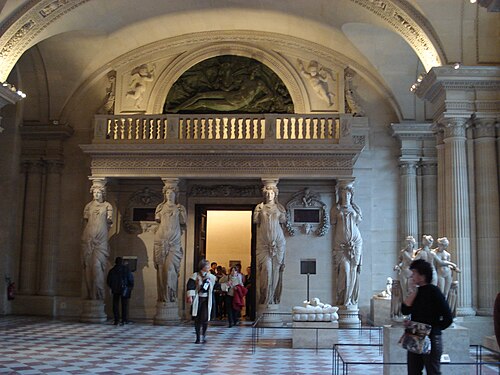Nymph of Fontainebleau
Sculpture by Benvenuto Cellini From Wikipedia, the free encyclopedia
The Nymph of Fontainebleau (French: Nymphe de Fontainebleau), also known as the Nymph of Anet (French: Nymphe d'Anet) or the Nymph with the Stag (French: Nymphe au cerf), is a c.‑1543 bronze relief (Paris, Louvre, MR 1706[1]), created by the Italian sculptor Benvenuto Cellini for the Château de Fontainebleau in France. It features a long-limbed reclining nude female nymph with a stag, wild boars, dogs, and other animals. It was Cellini's first large scale bronze casting.[2]

History
Summarize
Perspective
The sculpture was commissioned by François I, executed in Cellini's workshop at the Hôtel de Nesle (adjacent to the Tour de Nesle) in Paris, sculpted with the help of Thomas Dambry, Pierre Bontemps and Laurent Mailleu, and assembled with the help of foundrymen Pierre Villain and Guillaume Saligot.[1] Originally intended to be placed in the tympanum in the arch above the entrance of the Porte Dorée ("Golden Gate") at the Château de Fontainebleau, it was never installed there, but instead was used by the architect Philibert de L'Orme, who put it above the entrance gate (built c. 1552) of the Château d'Anet,[3] where the nymph became identified with Diana, the goddess of the hunt, representing the owner of the château, Diane de Poitiers,[4] and the stag with her lover Henri II of France.
The relief was seized on 23 March 1794, at the time of the French Revolution, and moved from Anet to the Nesle depot.[1] According to the French historian Maurice Roy, it was initially intended for the Musée des Monuments Français in Paris and was later replaced in Anet by a painted plaster cast.[5] On 23 February 1796, the Conservatoire des Arts decided it should be moved to the small courtyard of the Louvre, but in 1797, when it was actually moved to the Louvre, it was placed in the gallery of the museum.[1]
After the sculpture's restoration in 1811 by the father and son founder-chasers (French: ciseleurs) Delafontaine, it was installed by the architect Pierre-François Fontaine over the Caryatides Balcony in the Salle des Caryatides of the Lescot Wing, where it remained until 1847, when it was replaced with a cast by Antoine-Louis Barye and transferred to the Sculptures rooms. It was later moved to a landing of the Mollien Staircase above the ground floor of the Denon Wing of the Louvre, where it is currently on display.[1]
- The Nymph of Fontainebleau and its replicas
- Replica at the Château d'Anet
- Long view showing its location above the entrance gate at Anet
- Replica in the Salle des Caryatides of the Louvre
- Long view showing the Nymph above the balcony supported by the four caryatids sculpted by Jean Goujon
- Long view showing its location on the Mollien Stairs of the Louvre
- Close-up view of the original bronze by Cellini
See also
Wikimedia Commons has media related to Fontainebleau Nymph.
Notes
Bibliography
Wikiwand - on
Seamless Wikipedia browsing. On steroids.






